
The Use of Technology in Modern Urban Planning: Revolutionizing the Way Cities are Built
City planning is a complex and challenging field, but technology is making it easier and more efficient than ever before. From computer-aided design (CAD) software to cutting-edge technologies like generative AI, augmented reality, and blockchain, technology is changing the way cities are planned and built.
In this blog, we will explore how technology is revolutionizing urban planning and what it means for the future of our cities.
Computer-Aided Design (CAD) Software
For decades, urban planners have been using computer-aided design (CAD) software to help create detailed and accurate plans for new developments and infrastructure projects. With the help of CAD software, planners can create 3D models of proposed developments, visualize them from different angles, and make changes to the design quickly and easily. This has helped to speed up the planning process and ensure that projects are built to the highest standards.
Augmented Reality and Virtual Reality
While CAD software has been a game-changer in urban planning, the use of augmented reality (AR) and virtual reality (VR) is taking things to the next level. These technologies allow urban planners to create virtual simulations of proposed developments and infrastructure projects. This allows planners to see how their designs will look and function in the real world, which is particularly useful for large and complex projects. With AR and VR, planners can get a better understanding of how their designs will impact the environment, the local community, and the overall city.
Generative AI
Generative AI is a new and exciting technology that is starting to make its way into urban planning. It involves using artificial intelligence (AI) algorithms to generate designs based on a set of constraints and parameters. This has the potential to revolutionize urban planning by allowing planners to quickly and easily generate designs that are optimized for sustainability, efficiency, and livability.
For example, a generative AI algorithm could be programmed to generate designs for new housing developments that maximize green space, minimize energy consumption, and provide easy access to public transportation. The algorithm could then generate a range of designs that meet these criteria, allowing planners to choose the best design for their specific project.
Building Information Modeling (BIM)
Building Information Modeling (BIM) is another technology that is starting to play a big role in urban planning. BIM involves creating a digital model of a building or infrastructure project that includes detailed information about its design, construction, and maintenance. This information is stored in a central database, which can be accessed by different stakeholders throughout the life of the project.
By using BIM, urban planners can get a complete and up-to-date view of a project, which can help to reduce errors, improve communication, and speed up the construction process. It also helps to ensure that the project is built to the highest standards and meets all regulatory requirements.
Emerging Technologies
There are a number of other emerging technologies that have the potential to play a big role in the future of urban planning. For example, the Internet of Things (IoT), and blockchain technology have the potential to play a significant role in the future of urban planning.
The Internet of Things (IoT) is expected to play a big role in urban planning by allowing cities to become more connected and efficient. With IoT, city planners can collect and analyze real-time data from a wide range of sources, including traffic sensors, weather stations, and public transportation systems. This data can then be used to make informed decisions about how to improve city infrastructure and services.
Finally, blockchain technology has the potential to transform the way that cities are built and managed. By creating a decentralized, secure, and transparent ledger of transactions, blockchain can help ensure that urban planning and development projects are carried out in a fair and transparent manner. It can also help to reduce the risk of fraud and corruption, and ensure that all stakeholders have access to the information they need to make informed decisions.
Here are a few ways that emerging technologies can work together for urban planning:
- IoT sensors could be used to collect data on traffic, air quality, and other city metrics, which could then be analyzed using generative AI to optimize city layouts and inform urban planning decisions.
- Augmented reality could be used to create virtual simulations of proposed developments, which could then be analyzed using building information modeling (BIM) software to identify potential issues before construction even begins.
- Blockchain technology could be used to create a secure, decentralized, and transparent platform for managing development projects, ensuring that all stakeholders have access to the information they need to make informed decisions.
- The use of drones and other aerial imaging technology could be used to create detailed 3D maps of cities, which could be used to inform planning decisions and identify potential areas for development.
By leveraging the power of these technologies in combination, cities can become smarter, more efficient, and more sustainable, helping to create a better quality of life for residents and a brighter future for our urban environments.
Conclusion
In conclusion, technology is playing a major role in revolutionizing the way that cities are planned and built. From CAD software to generative AI, augmented reality, and blockchain, technology is making the urban planning process faster, more efficient, and more sustainable. As technology continues to evolve, we can expect to see even more innovative solutions emerge that will help create smarter, more livable cities for the future.










